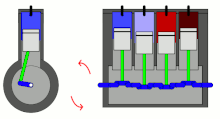1.
Frame. The framework of the diesel
engine is the load carrying part of the machinery.
2.
Oil drain pan. The oil drain pan is
attached to the bottom of the cylinder block and serves to collect and drain
oil from the lubricated moving parts of the engine.
3.
Access doors and inspection covers. The
cylinder block walls are equipped with access doors or
4.
5.
handhole covers. With the doors
or covers removed, the openings furnish access to cylinder liners, main and
connecting rod bearings, injector control shafts, and variousThe doors are
usually secured with handwheel or nut operated clamps and are fitted with
gaskets to keep dirt and foreign material out of the interior
6.
Cylinder head. The cylinder head seals
the end of the cylinder and usually carries the valves. Heads must be strong
enough to withstand the maximum pressures developed in the cylinders.
7.
Crankshaft. The crankshaft transforms
the reciprocating motion of the pistons into rotary motion of the output shaft.
It is one of the largest and most important moving parts of a diesel engine.
crankshafts are always heat treated. This is necessary in order to give uniform
grain structure, which increases ductility and capacity for resisting shock.
8.
Main bearings. The function of the main
bearings is to provide supports in which the crankshaft main bearing journals
may revolve
9.
Pistons. The function of a piston is to
form a freely movable, gastight closure in the cylinder for the combustion
chamber. When combustion occurs, the piston transmits the reciprocal motion or
power created to the connecting rod.
10.
Piston rings. Piston rings have the
following three primary functions:1. To seal compression in the combustion
chamber.2. To transfer heat from the piston to the cylinder wall.3. To
distribute and control lubricating oil on the cylinder wall.
11.
Piston pins. Each piston is connected to
the connecting rod by a piston pin or wrist pin. This connection is through
bored holes in the piston pin hubs at the center of the piston and the integral
hub of the connecting rod.
12.
Connecting rods. Just as its name
implies, the connecting rod connects the piston with the crankshaft. It
performs the work of converting the reciprocating, or back-and-forth, motion of
the piston into the rotary, or circular, motion of the crankshaft.
13.
Connecting rod bearings. The purpose of
these bearings is to form a low-friction, well-lubricated surface between the
connecting rod and the crankshaft in which the crankpin journals can revolve
freely.
14.
Valve. Control of the flow of fuel,
inlet air, starting air, and exhaust gases in a diesel cylinder is accomplished
by means of various types of valves.
15.
Exhaust valves. Exhaust valves are used
to allow the exhaust gases of combustion to escape from the cylinders.
16.
Fuel injection valves. Fuel injection
valves are used to inject the fuel spray into the cylinder at the proper time
with the correct degree of atomization. In addition, some injection valves also
measure the amount of fuel injected
17.
Air starting valves. Air starting valves
are used to control the flow of starting air during air starting of an engine.
18.
Cylinder test valves. Each cylinder is
provided with a test valve which is used to vent the cylinder before starting.
This valve is also used to relieve the cylinder of compression when turning
over the engine by hand
19.
Cylinder relief valves. A cylinder
relief, or safety, valve is located on each cylinder of all submarine type
engines. The function of this valve is to open and relieve the cylinder when
pressure inside the cylinder becomes excessive.
20.
Camshafts. The purpose of the camshafts
in submarine diesel engines is to actuate exhaust valves, fuel injectors, fuel
injection pumps, and air starting valves according to the proper timing
sequence of that particular engine.





